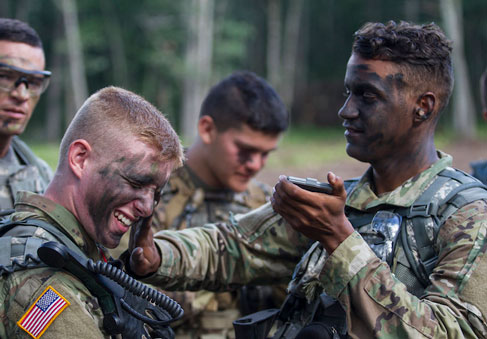Have you ever been in a group setting where you have an idea you think would be really valuable, but your gut tells you not to share it? If you find yourself focusing on the risks of sharing your idea rather than its potential value, you might be in a group that lacks trust.
Group trust is a belief among members that they can be honest, take risks, be themselves, and be supported by the rest of the group. When group trust is low, it can undermine group resilience, productivity, and motivation. When group trust is high, the group can be more productive, more creative, better at having difficult conversations, better at growing from failure, and better at problem solving. Also, each individual in the group benefits by being more satisfied and more resilient.
You probably belong to many groups that can provide the social support you need to thrive in your service to the military or personally through your family, friends, community, and clubs. Try these tactics to maintain and build group trust:
-
Have fun together! Positive emotions such as joy, gratitude, and enthusiasm can help you be more open to people, opportunities, and new ideas. Sharing them with others helps to develop strong relationships within the group.
To build positive emotions in a group, find ways to move together or sing together. The military already excels at this through activities such as a military cadence. You might not want to line up your family or church group for a run chanting “left, left, left, right, left.” But you might go on a community bike ride, play kick ball, chant the fight song of your favorite sports team, or do karaoke to help unite your group.
Another way to strengthen a group bond, increase trust, and decrease conflicts amongst the group is to create opportunities for others to share their successes. By showing authentic, enthusiastic support and helping group members to relive the experience, you become an “excitement magnifier.” Create routines or rituals where people share successes or high points of their days. Meals and regularly scheduled meetings can be good times to share such highlights.
- Show vulnerability. Most people like to at least appear they have their “act together,” but showing that you sometimes make mistakes or struggle can help build trust. You can do this by owning up to current mistakes and what you learned or by sharing the different challenges you have overcome to get to this point in your career. This can help other members of the group to feel safe sharing their mistakes and struggles. Obviously, it’s important to set limits, but people owning up to and learning from their mistakes will help any type of group perform better.
- Define your group’s identity. Each branch of the military has its own motto and set of core values, such as the Marine Corps’ “Semper Fidelis” (always faithful) and the Army’s core values of loyalty, duty, respect, selfless service, honor, integrity, and personal courage. Defining common values, goals, and beliefs can unite group members to a cause greater than themselves. Think about your family or other groups you belong to. What does the group stand for? What distinguishes it from other groups? What behaviors do the members hope to live out? By discussing these with the members of your group, you can help define the group’s identity and set its standards of behavior. Then, get creative and come up with a set of core values, your mission statement, a group slogan, or all three. This is also a great activity to do with your family.
Bottom line
To set up your group for success, create opportunities for building and maintaining group trust.
